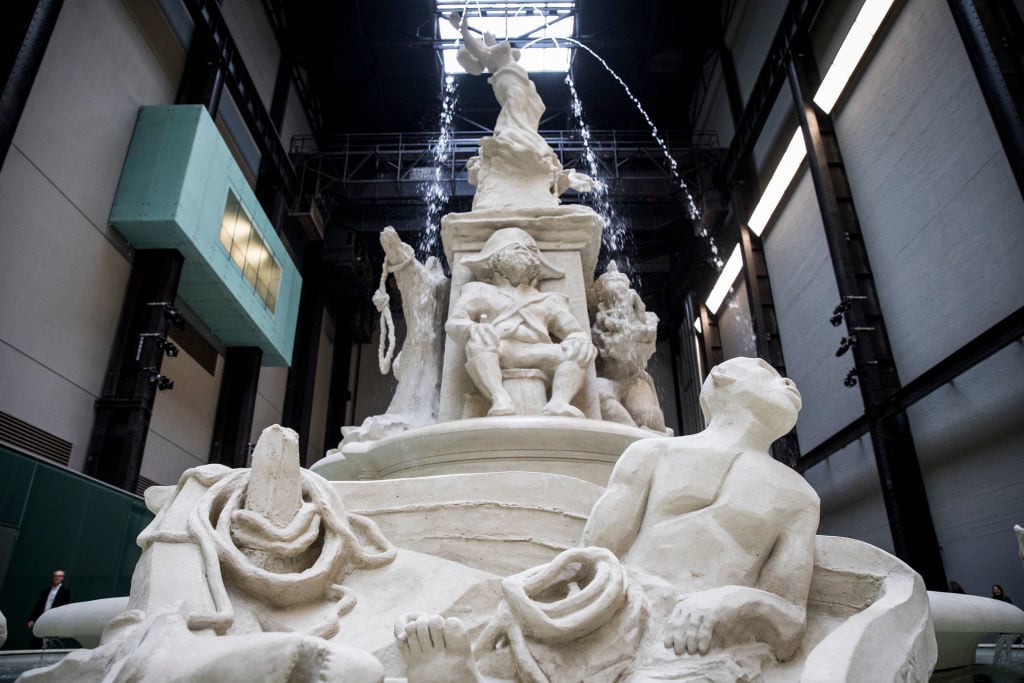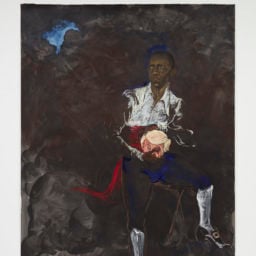You can hear it before you see it. The sound of rushing water fills Tate Modern’s vast Turbine Hall in London. As you round the corner, you encounter its source: an enormous fountain at the far end of the space, designed by the American artist Kara Walker.
The highly anticipated monumental work—the fifth annual Turbine Hall commission underwritten by Hyundai Motor Company—is an indictment of the violent history of the British Empire and, more pointedly, of the way that history is memorialized and sanitized in public sculpture. At the press preview, Walker noted that monuments have a tendency “to get some of the story wrong or embellish different parts of the story.”
The sweeping work is modeled after the Victoria Memorial in front of Buckingham Palace, an homage to Queen Victoria that was funded in part by proceeds from goods sent over from West Africa. Called Fons Americanus, Walker’s scaled-down version—the 40-foot-tall work is about half the size of the original—presents an alternative reading of this and other memorials to the British Empire, foregrounding the racist and violent history that underpins them and injecting it with a shot of her characteristic dark humor.
Walker said she had been “perversely moved” by the grandeur of colonial-era monuments and European baroque constructions like Rome’s Trevi Fountain when she first came to Europe as an art student. “It really is very jarring if you think about… what that is built on the backs of,” she said.
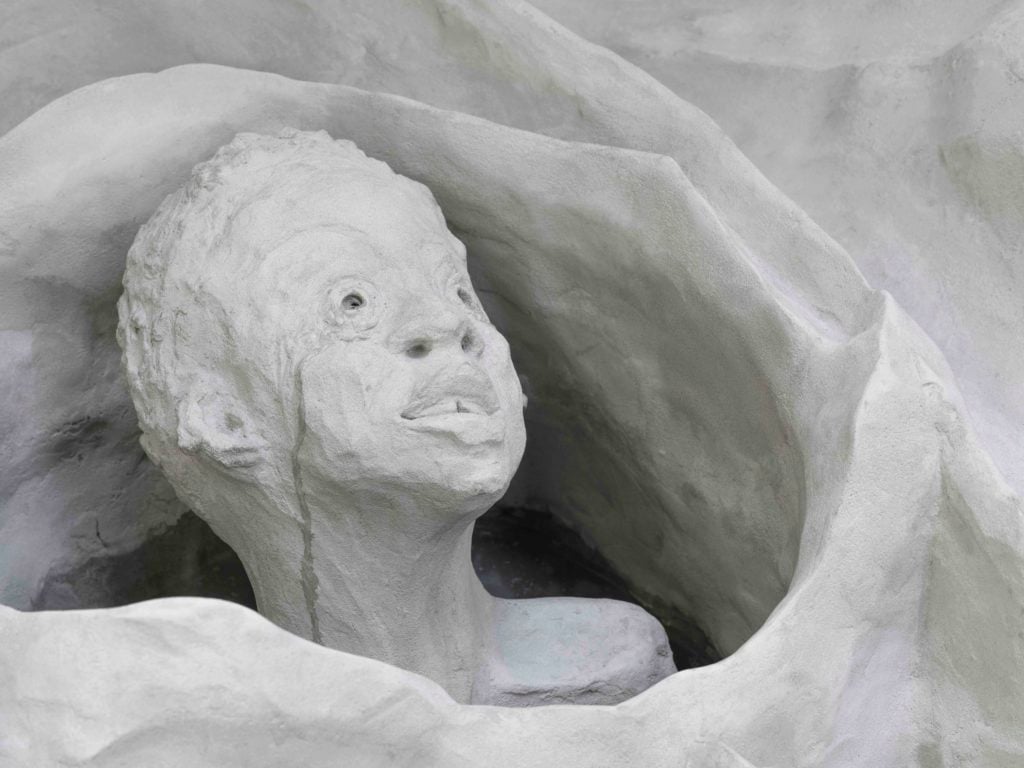
Installation view of Kara Walker’s Turbine Hall Commission 2019, Fons Americanus. ©Tate photography, Photo by Matt Greenwood.
Her interest in interrogating Europe’s colonial-era monuments coincides with a similar dialogue underway in the United States over the fate of Confederate monuments. In the US, Walker noted, this debate has “unearthed the racisms and cruelties that have lived fairly quietly under the surface for quite some time.” (Kehinde Wiley’s towering figure on horseback, recently unveiled in New York’s Times Square, offers a stateside echo of this conversation.)
“I think that the Confederate debate has been interesting in that it really makes me feel that the US is a very young country,” Walker continued. “It has only been really recently that there has been this concerted national conversation about what those monuments are, how they got there, and what they mean.”
An Origin Story
The water in Walker’s fountain evokes both primordial beginnings and the transatlantic slave trade, which brought the ancestors of many African Americans to the US. The sculpture is topped with an African Venus figure, inspired in part by a slave propaganda image, The Voyage of the Sable Venus from Angola to the West Indies, which celebrated and romanticized the traumatic Middle Passage. Twin streams of water pour from her breasts, with a third sprouting rather gruesomely from a gape in her neck. As usual, Walker does not shy away from the grotesque.
On the front of the fountain, given pride of place, is a sea-captain figure. He is a composite of different characters from history and fiction, all of whom started out as freedom fighters but whose legacies were complicated by their hunger for power: Toussaint Louverture, the leader of the Haitian Revolution; Emperor Jones, the titular character in a Eugene O’Neill play; and civil-rights advocate Marcus Garvey.
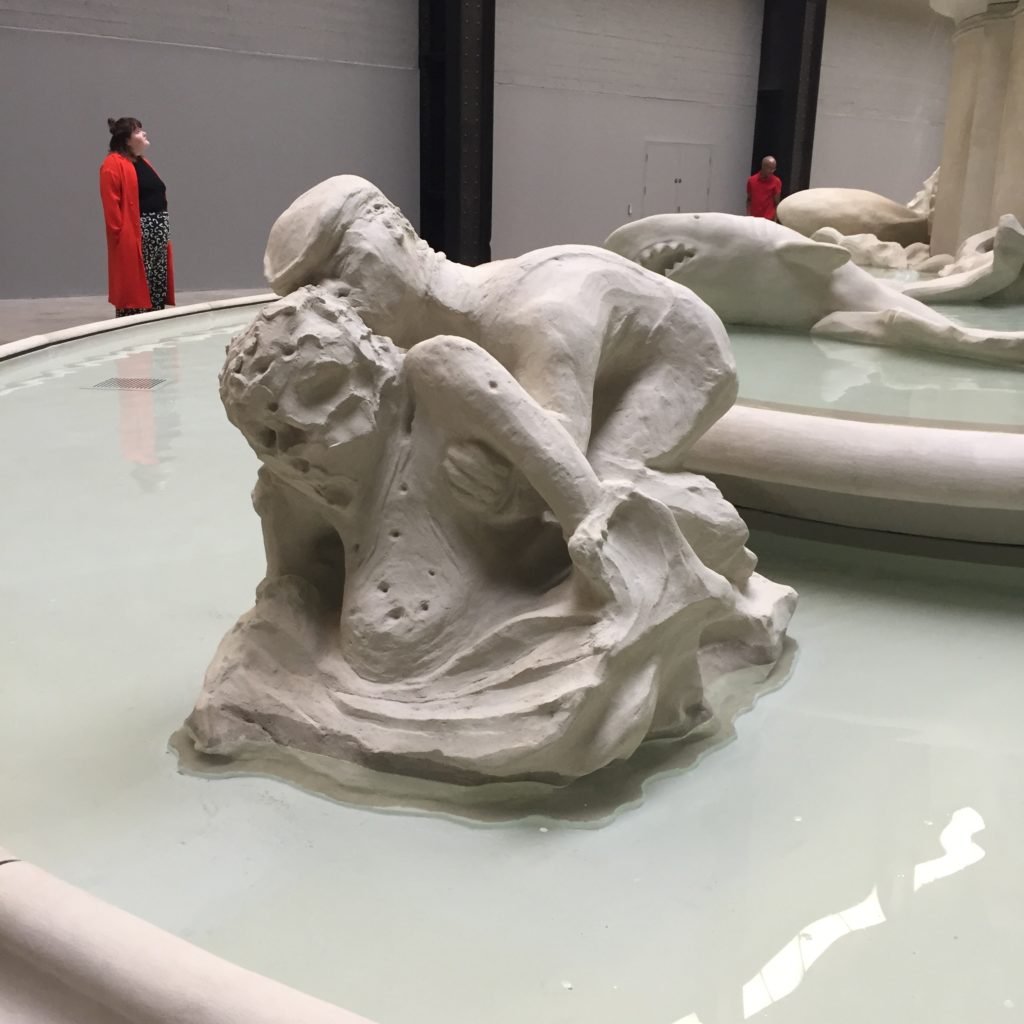
Installaton view of Kara Walker’s Fons Americanus (2019). Photo by Naomi Rea.
The piece is so loaded with art-historical and cultural references that you could teach an entire college history course without leaving Turbine Hall. A Venus shell doubles as a well of tears that references Bunce Island in Sierra Leone, a base for European slave traders where tens of thousands of Africans were brought before being forced into slavery in the North American colonies of South Carolina and Georgia.
Other references include JMW Turner’s 1840 Slave Ship, a painting that memorializes an episode from 1781 in which slavers threw people from a boat headed for Jamaica in order to collect insurance money; Damien Hirst’s formaldehyde shark; John Singleton Copley’s celebrated maritime painting, Watson and the Shark (1778); and even Kanye West (whose name, K. West, is reproduced on a boat drawn from Winslow Homer’s 1899 painting Gulf Stream). Snorkeled and goggled mermaids splash around a lynching tree; nearby, a male figure lifts up a barely discernible human figure whose visage is a reference to the mangled face of Emmett Till.
Excavating Histories
In both form and content, the sculpture aims to challenge our understanding of monuments as fixed and true. The work is made from jesmonite (a mix of acrylic and cement) over cork, as opposed to the bronze and marble of the royal monument that inspired it. Curator Clara Kim explained that the fountain was deliberately given a rough finish so that it would appear to be in the process of being formed or eroded.
“These are histories that have not been recognized properly, and histories that are continuing to be explored,” Kim said. “She is challenging the language of monuments themselves, the fact that they do represent power and domination, and subverting that language of how one represents history, and specific moments in history.”
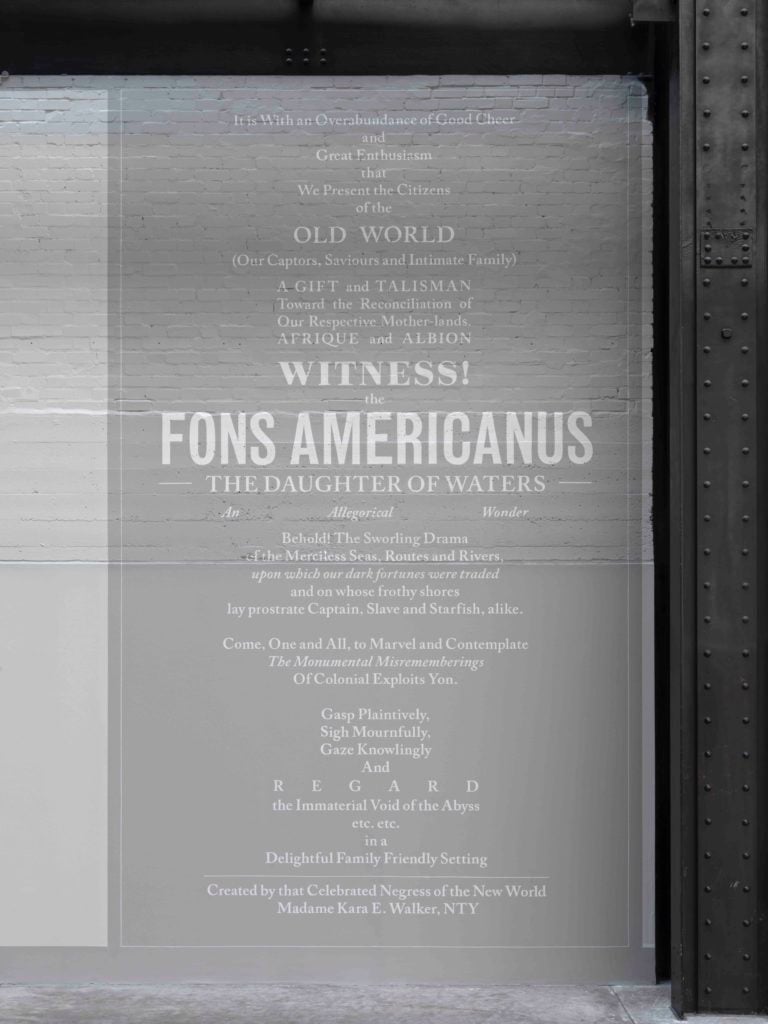
Installation view of Kara Walker’s Turbine Hall Commission 2019, Fons Americanus. ©Tate photography, Photo by Matt Greenwood.
The full title of the work—which reads like a poem—is painted on the wall (see above). Like the full title for her most recent gallery exhibition in New York, the text resurrects and subverts the language of 19th-century runaway slave posters and advertisements for freak shows. But the title also draws on Latin, a language used to communicate something so old that, we imagine, it must be unquestionably true.
“She was interested in an origin story so she turned to a Latin name for it, in the way that a lot of monuments reference and weave together Greek and Roman mythology as the origin of a culture of a nation,” Kim said. “Hopefully, it will lead others to go out into the streets of London and see these monuments, and think about why they’re really there.”
“Kara Walker: Fons Americanus” will be on view in Tate Modern’s Turbine Hall from October 2 through April 5, 2020.
